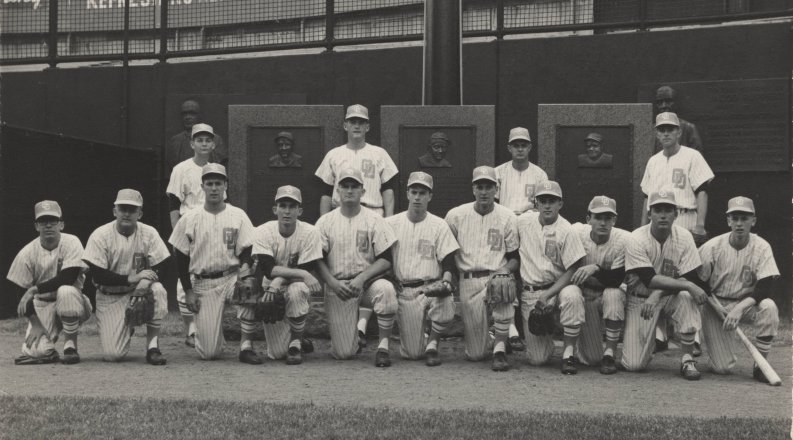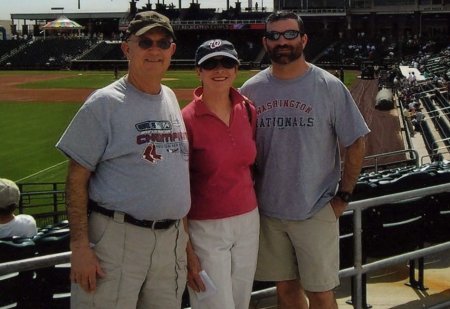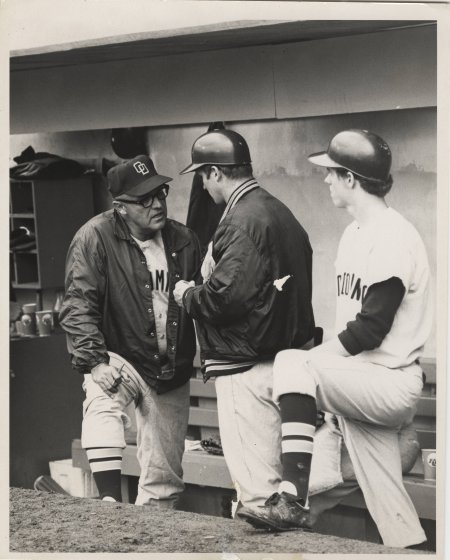The role athletics played in enhancing Old Dominion University’s overall national profile has been well chronicled.
The 1975 Division II men's basketball national title, three women's basketball national crowns, two football victories over Virginia Tech and star players such as Nancy Lieberman, Inge Nissen, Dave Twardzik and Taylor Heinicke all helped spread the word about the University to millions.
But the role Bud Metheny played in the school's early days isn't as well known.
Author Jay Ingram (right) with his parents John and Arlene.
Jay Ingram, an engineer with a history degree from the College of William & Mary, fills that gap with a book titled “Monarchs: Bud Metheny, Old Dominion Baseball and the Foundational 1960s Championship Teams."
Ostensibly, the book is about Old Dominion baseball teams in the early 1960s that first brought the school national acclaim.
The 1964 Monarchs finished 22-3 and won the championship of the "Little Eight," a loose amalgam of Virginia college division schools, as well as the Mason-Dixon Conference title. The Monarchs then defeated Buffalo and Long Island University to win the NCAA College Division East Regional at Yankee Stadium.
This from a college that was only two years removed from being an extension of William & Mary.
It was the second East Regional title in a row at a time when there were no national playoffs for small colleges. Although the 1964 regional games were sparsely attended, they commanded national media attention, with the New York Times and New York Daily News among newspapers covering the event. The Associated Press story about the regional final put Old Dominion in hundreds of newspapers for the first time.
The 1964 team was loaded. Five members would be inducted into the ODU Sports Hall of Fame, four would be named All-Americans and two would be Major League Baseball draft choices.
But the book chronicles far more than that one season. It starts with the University's founding in 1930 and takes the readers on a fascinating narrative of how Joseph "Scrap" Chandler and later Metheny used athletics to help grow the University’s reputation.
Ingram spent hundreds of hours in the archives at the ODU library. He also had a big assist from James R. Sweeney, an ODU history professor emeritus who has written extensively on the University's history.
"Everyone knew," Metheny told Sweeney in 1975, "that we could be recognized nationally much quicker through the realm of athletics than we could with any other means."
Ingram's father, John Ingram, was a left-handed pitcher for Old Dominion in 1964 and coached Virginia Beach's Cox High School to a state championship. He died in 2020 while his son was researching the book.
Ingram’s research began as something of a family project, a way to chronicle the history of his father and mother. His mom, Arlene, was the 1964 class president at then-Old Dominion College.
"As I started researching the project, the thesis changed," said Ingram, a Virginia Beach native. Athletics, and especially that 1964 baseball team, "had such an impactful influence on the community and the school."
"How does a fledging college gain name recognition? How does this become a University of 25,000 students?" he added. "In some ways (the baseball players from the 1960s) were the architects of the University as it is today."
Chandler came to Norfolk in 1942 and was the school's athletic director until 1963, when Metheny took over. He hired Metheny in 1948 as basketball and baseball coach. With meager budgets, they began to schedule ambitiously.
"It's a difficult process," Metheny said in 1975, "because sometimes the boys will get discouraged when they get beat. "But later on in life, by playing this kind of competition, they found out that to be a competitor you have to compete against the better ones if you're going to be successful."
Chandler and Metheny pushed for the Norfolk Division to become a member of Virginia's Little Eight – the Big Five included Virginia and Virginia Tech – and then the Mason-Dixon Conference. They did so even though the school had subpar facilities.
Baseball games were played at Larchmont Elementary School and the team practiced at Lafayette Park, 2 miles from campus. Sometimes there were so many pebbles in the dirt at Larchmont that infielders couldn’t predict where the ball would go.
The gym where ODU played basketball and where the swim team worked out had just two showers. Basketball games were often played at local high schools.
Metheny was a former William & Mary star who played parts of four seasons with the New York Yankees. He was the last player to wear Babe Ruth's No. 3 jersey.
Metheny was a blue-collar guy, and Old Dominion appealed to blue-collar kids. Full athletic scholarships weren't the norm, and for local stars, playing at Old Dominion made financial sense.
The Monarchs got very good very fast in baseball and developed a camaraderie that Ingram said came across in interviews.
In 1964, Metheny was named College Division national coach of the year. His status as a former Yankee helped ODU baseball receive a ton of media attention.
A year later, Metheny stepped down as basketball coach and hired Sonny Allen to replace him. Six years later, ODU played for a national basketball championship before winning the Division II title in 1975.
ODU was then just two years away from becoming a Division I school.
"I realize the book will appeal to a niche audience," said Ingram, whose family endowed a scholarship in his parents’ name and is donating proceeds from sales of the book to that fund. "You have to be from ODU or love baseball or be from Norfolk to want to read this book."
Allen, former athletic director Jim Jarrett, former men's basketball coach Paul Webb, women's basketball coach Marianne Stanley and others are deservedly credited for the growth of ODU athletics.
If you read this book, you will know the names of others who were also pioneers – Wayne Parks, Fred Kovner, Bob Walton and Frank and Jimmy Zadell.
"It's a good bunch of guys, a humble bunch of guys, who accomplished so much," Ingram said. "The University owes them for what the University is today.”





